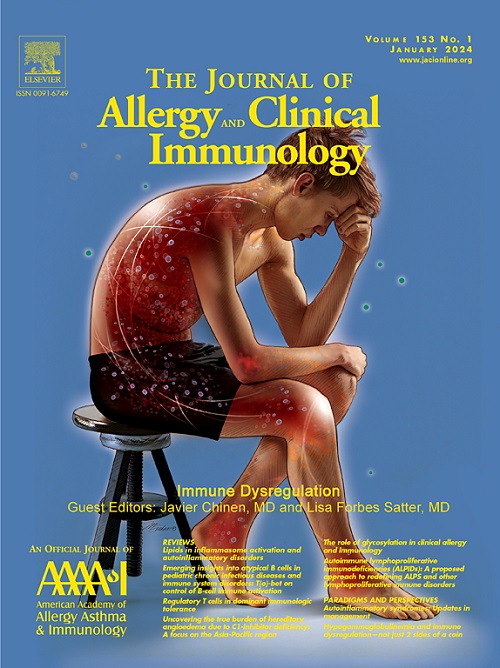腺苷脱氨酶2的缺乏使适应性免疫功能偏向特定的T和B细胞受体。
IF 11.4
1区 医学
Q1 ALLERGY
引用次数: 0
摘要
背景:腺苷脱氨酶2缺乏症(DADA2)是由编码调节细胞外腺苷代谢的蛋白脱氨酶的ADA2基因的双等位次形或功能丧失突变引起的一种遗传性疾病。临床特征包括炎症性血管病变,早发性中风,以及涉及免疫缺陷和自身炎症/自身免疫的复杂表现。目的:确定dada2特异性适应性免疫结构。方法:我们分析了47例先前报道的和5例未报道的DADA2患者的免疫球蛋白水平和外周B细胞和T细胞表型。在接受或未接受抗tnf治疗的患者中,21种细胞因子/趋化因子的水平被量化。为了表征DADA2的免疫结构,我们进行了T和B细胞受体(TCR/BCR)免疫测序。我们训练了一个二元LightGBM分类器来区分健康人的DADA2 T和B细胞免疫谱。结果:65%的DADA2患者(34/52)检测到低丙种球蛋白血症,48%的患者(25/52)检测到细胞减少。流式细胞分析显示B细胞和T细胞记忆区收缩。此外,我们观察到TNF、IL-8、几种干扰素、APRIL、BAFF和sCD40L水平升高。在抗TNF治疗下,血清TNF、BAFF和sCD40L水平持续升高。下一代外周淋巴细胞免疫测序显示TCR库和B细胞受限,尤其倾向于IGHV4-34重排。我们的机器学习算法基于B细胞克隆分数、CDR3长度和选定的Kidera因子等免疫遗传学参数,从健康个体中高精度地分离出DADA2。结论:我们的研究结果强调了ADA2对适应性免疫系统的显著影响,这导致DADA2患者具有高度特异性的免疫遗传学特征。本文章由计算机程序翻译,如有差异,请以英文原文为准。
Deficiency of adenosine deaminase 2 skews adaptive immune repertoires toward specific sets of T- and B-cell receptors
Background
Adenosine deaminase 2 deficiency (DADA2) is a genetic disorder caused by biallelic hypomorphic or loss-of-function mutations in the ADA2 gene, which encodes a protein deaminase regulating extracellular adenosine metabolism. Clinical features encompass inflammatory vasculopathy, early-onset strokes, and a complex presentation involving both immunodeficiency and autoinflammation/autoimmunity.
Objective
Our aim was to determine a DADA2-specific adaptive immune architecture.
Methods
We profiled immunoglobulin levels and peripheral B- and T-cell phenotypes in 47 previously reported and 5 unreported patients with DADA2. Levels of 21 cytokines and chemokines were quantified in patients with or without anti-TNF treatment. To characterize the DADA2 immune architecture, we performed T- and B-cell receptor immunosequencing. We trained a binary LightGBM classifier to distinguish DADA2 T- and B-cell immune repertoires from healthy individuals.
Results
We detected hypogammaglobulinemia in 65% of patients with DADA2 (34 of 52) and cytopenias in 48% (25 of 52). Flow cytometric profiling revealed contraction of B- and T-cell memory compartments. In addition, we observed elevated levels of TNF, IL-8, several interferons, a proliferation-inducing ligand (APRIL), B-cell activating factor (BAFF), and soluble CD40 ligand (sCD40L). High serum levels of TNF, BAFF, and sCD40L persisted under anti-TNF therapy. Next-generation immunosequencing of peripheral lymphocytes showed restricted T-cell receptor repertoires and B cells, which were particularly skewed toward immunoglobulin heavy chain V4-34 rearrangements. With high accuracy, our machine learning algorithm separated individuals with DADA2 from healthy individuals on the basis of immunogenetic parameters regarding B-cell clone fraction, CDR3 length, and selected Kidera factors.
Conclusions
Our findings underscore the significant influence of ADA2 on the adaptive immune system, which results in a highly specific immunogenetic signature in patients with DADA2.
求助全文
通过发布文献求助,成功后即可免费获取论文全文。
去求助
来源期刊
CiteScore
25.90
自引率
7.70%
发文量
1302
审稿时长
38 days
期刊介绍:
The Journal of Allergy and Clinical Immunology is a prestigious publication that features groundbreaking research in the fields of Allergy, Asthma, and Immunology. This influential journal publishes high-impact research papers that explore various topics, including asthma, food allergy, allergic rhinitis, atopic dermatitis, primary immune deficiencies, occupational and environmental allergy, and other allergic and immunologic diseases. The articles not only report on clinical trials and mechanistic studies but also provide insights into novel therapies, underlying mechanisms, and important discoveries that contribute to our understanding of these diseases. By sharing this valuable information, the journal aims to enhance the diagnosis and management of patients in the future.

 求助内容:
求助内容: 应助结果提醒方式:
应助结果提醒方式:


